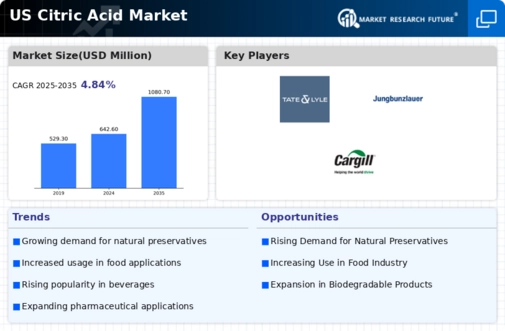Growing Health Consciousness
The increasing awareness of health and wellness among consumers is driving the citric acid market. As individuals seek healthier food options, citric acid is gaining traction due to its natural preservative properties and ability to enhance flavor without adding calories. In the US, the demand for low-calorie and sugar-free products is on the rise, with the food and beverage sector incorporating citric acid as a key ingredient. This trend is reflected in the market data, which indicates that the food and beverage industry accounts for approximately 70% of citric acid consumption. The citric acid market is likely to benefit from this shift as manufacturers adapt their products to meet consumer preferences for healthier alternatives.
Rising Use in Pharmaceuticals
The pharmaceutical sector's increasing reliance on citric acid is emerging as a notable driver for the citric acid market. Citric acid is utilized in various pharmaceutical formulations, including effervescent tablets and syrups, due to its ability to enhance solubility and stability. The US pharmaceutical market is anticipated to reach approximately $600 billion by 2026, suggesting a growing opportunity for citric acid applications. As the demand for innovative drug formulations rises, the citric acid market is likely to see a corresponding increase in consumption, particularly in the development of new therapeutic products.
Emerging Applications in Personal Care
The expansion of the personal care industry is presenting new opportunities for the citric acid market. Citric acid is increasingly being used in cosmetic and personal care products for its pH balancing properties and as a natural exfoliant. The US personal care market is projected to grow significantly, with a focus on natural and organic products. This trend suggests that the citric acid market may experience increased demand as manufacturers seek to formulate products that align with consumer preferences for natural ingredients. The versatility of citric acid in personal care applications could further drive its market growth.
Expansion of the Food Processing Industry
The growth of the food processing industry in the US is a significant driver for the citric acid market. As food processing techniques evolve, the need for effective preservatives and flavor enhancers becomes paramount. Citric acid serves as a versatile ingredient in various processed foods, including sauces, dressings, and canned goods. The US food processing industry is projected to grow at a CAGR of around 3% over the next few years, which could lead to increased demand for citric acid. This growth in the food processing sector is expected to bolster the citric acid market, as manufacturers seek to improve product quality and shelf life.
Regulatory Support for Natural Ingredients
The regulatory landscape in the US is increasingly favoring the use of natural ingredients, which is positively impacting the citric acid market. Regulatory bodies are promoting the use of safe, natural preservatives in food and beverages, aligning with consumer preferences for clean label products. This shift is likely to enhance the market position of citric acid, as it is recognized as a safe and effective ingredient. The citric acid market stands to gain from this regulatory support, as manufacturers are encouraged to incorporate citric acid into their formulations to comply with evolving standards and consumer expectations.














Leave a Comment